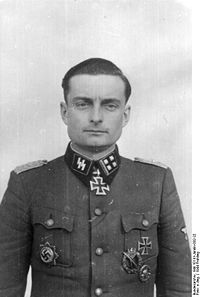- Manfred Schönfelder
-
The title of this article contains the character ö. Where it is unavailable or not desired, the name may be represented as Manfred Schoenfelder.
Manfred Schönfelder 
Born 18 March 1912
Hellerau, GermanyDied 4 March 1983 Allegiance  Nazi Germany
Nazi GermanyService/branch  Waffen-SS
Waffen-SSYears of service 1933–1945 Rank Obersturmbannführer (Lieutenant Colonel) Unit 5th SS Panzer Division Wiking Battles/wars World War II Awards Knight's Cross of the Iron Cross
German Cross in Gold
Iron Cross 1st Class
Iron Cross 2nd Class
Wound Badge
Infantry Assault BadgeManfred Schönfelder was a Obersturmbannführer (Lieutenant Colonel), in the Waffen-SS during World War II who was awarded the Knight's Cross of the Iron Cross, which was awarded to recognize extreme battlefield bravery or successful military leadership by Nazi Germany during World War II.
Manfred Schönfelder was born on the 18 March 1912 at Hellerau near Dresden. [1]
After completing his high school education, he joined the SS and was one of the first members to attend the SS-Junkerschule at Bad Tölz. [1]
After graduation he was promoted to Untersturmführer (Second Lieutenant) and posted to the SS Standarte Deutschland. [1]
He eventually became the Adjutant of the III. Battalion Deutschland Regiment and commander of the 12th Machine Gun Company, during the Polish Campaign and the Battle of France. [1]
In February 1941 he was given command of the Germania Regiment for the invasion of Russia, (Operation Barbarossa).[1]
From September 1942 to January 1943 he was on the staff of the 5th SS Panzer Division Wiking.[2]
During fighting at the Cherkassy pocket, Schönfelder prevented the loss of the entire divisions artillery, which enabled them to hold out for a further 24 hours and then made it possible for the division to withdraw over the rough terrain.[1]
They were also then able to hold back the Russians and prevent the division from being trapped and allow them to breakout. For these actions on the 23rd February 1944 Manfred Schönfelder was awarded the Knight's Cross of the Iron Cross.[1] [3]
Manfred Schönfelder survived the war and died on 4 March 1983.[1]
References
- Mattson, Gregory SS-The realm. The History of the Second SS division, 1939-45. Staplehurst 2002, ISBN 1862271445
- Fellgiebel, Walther-Peer. Die Träger des Ritterkreuzes des Eisernen Kreuzes 1939-1945. Friedburg, Germany: Podzun-Pallas, 2000. ISBN 3-7909-0284-5.
Categories:- 1912 births
- 1983 deaths
- SS officers
- Recipients of the Knight's Cross
Wikimedia Foundation. 2010.
